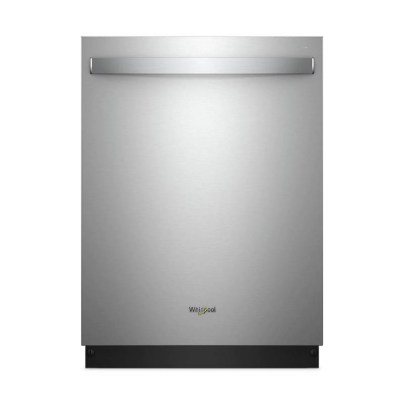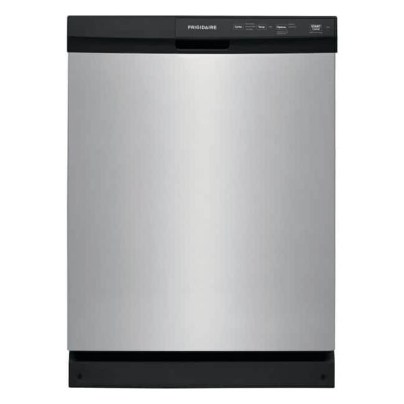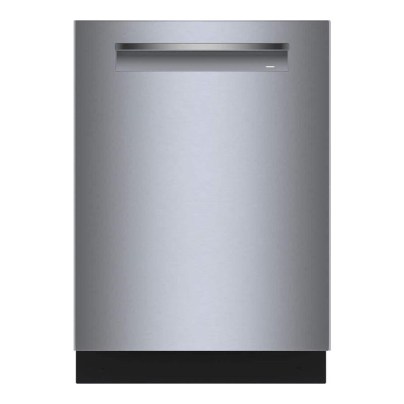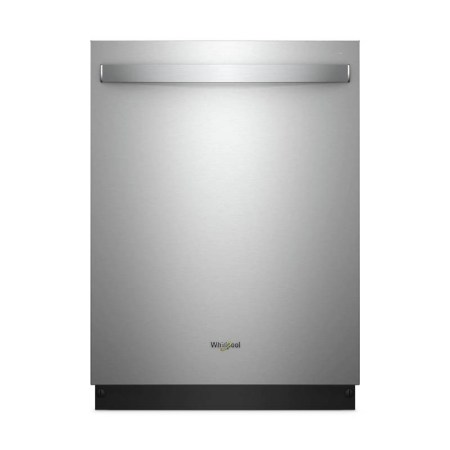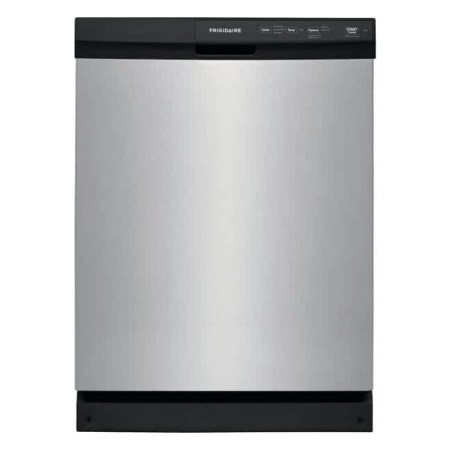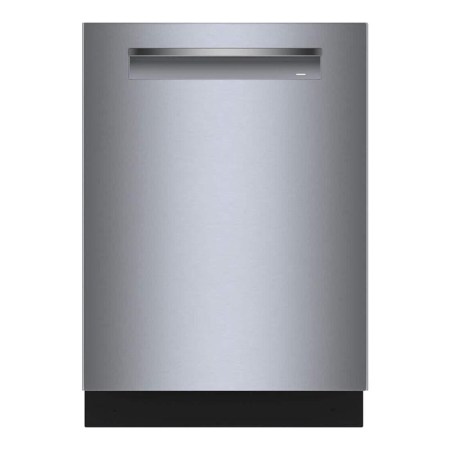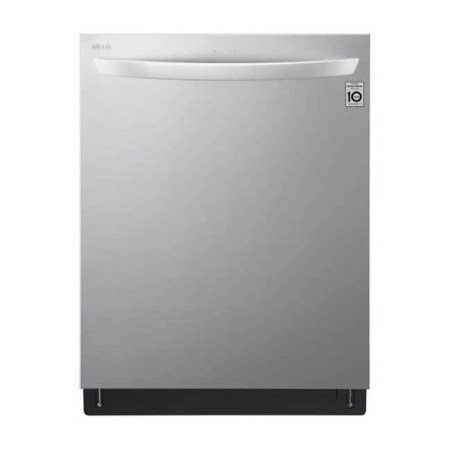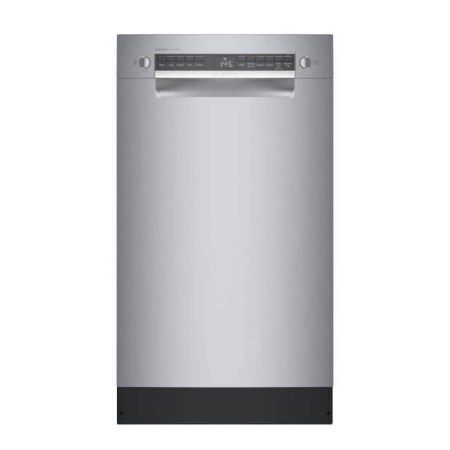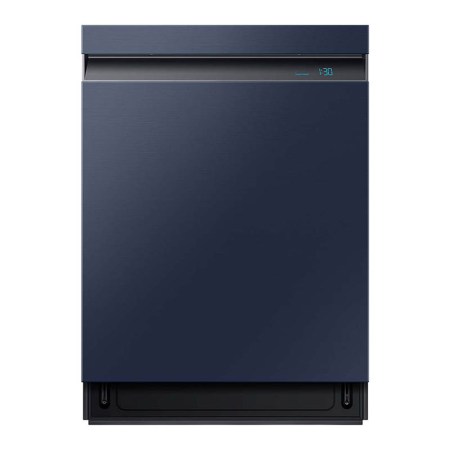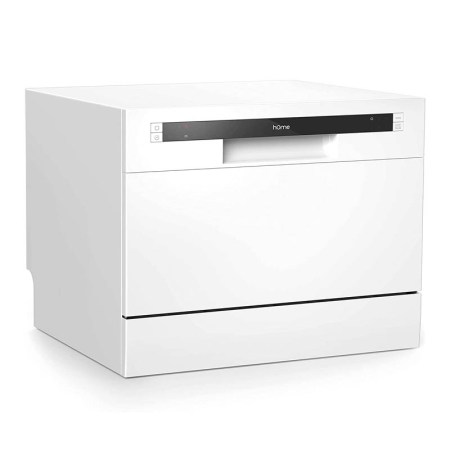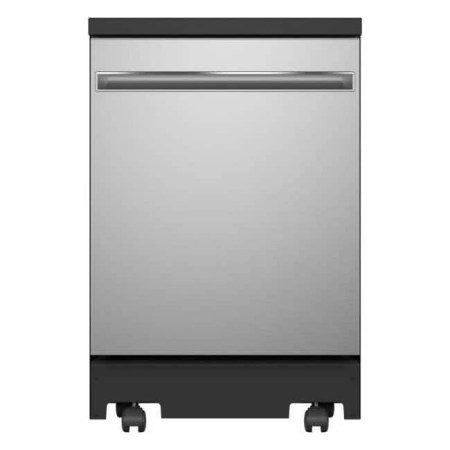We may earn revenue from the products available on this page and participate in affiliate programs. Learn More ›
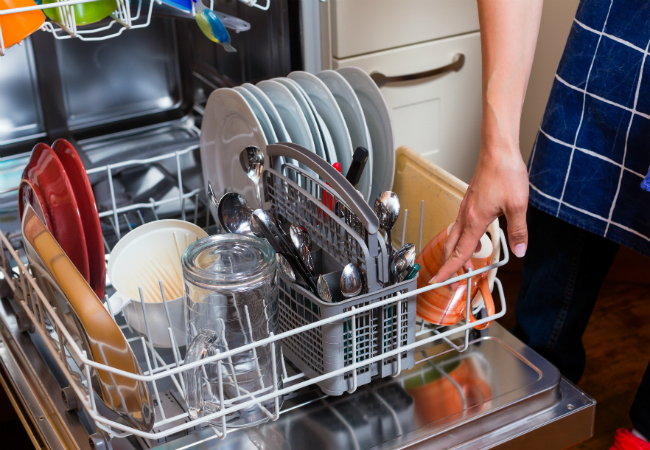
Hand-washing through a pile of pots, mixing bowls, and place settings can take hours—and an estimated 230 hours every year. On top of that, dishwashers use far less water than hand-washing, saving roughly 20 gallons per load. That may be enough time and water wasted to make you reconsider the best dishwasher for your needs, whether you’re installing your first unit or upgrading an existing appliance.
There are multiple types offered with ample wash cycles, racks, and special features, making dish cleaning hassle-free. We explore the important factors to consider when shopping for the best dishwasher and reviews some of the top-rated brands and models on the market to help people spend less time standing at the sink.
- BEST OVERALL: Whirlpool 24-Inch Top Control Built-In Dishwasher
- BEST BANG FOR THE BUCK: Frigidaire 24-Inch Front Control Built-In Dishwasher
- UPGRADE PICK: Bosch 800 Series 24-Inch Dishwasher with Crystal Dry
- BEST SMART: LG Electronics 42dBA Smart Dishwasher QuadWash
- BEST COMPACT: Bosch 300 Series 18-Inch Compact Dishwasher
- BEST LARGE-CAPACITY: Samsung – Smart Bespoke Linear Wash 39dBA Dishwasher
- BEST COUNTERTOP: HomeLabs Compact Countertop Dishwasher
- BEST PORTABLE: GE 24-Inch 54dBA Portable Dishwasher
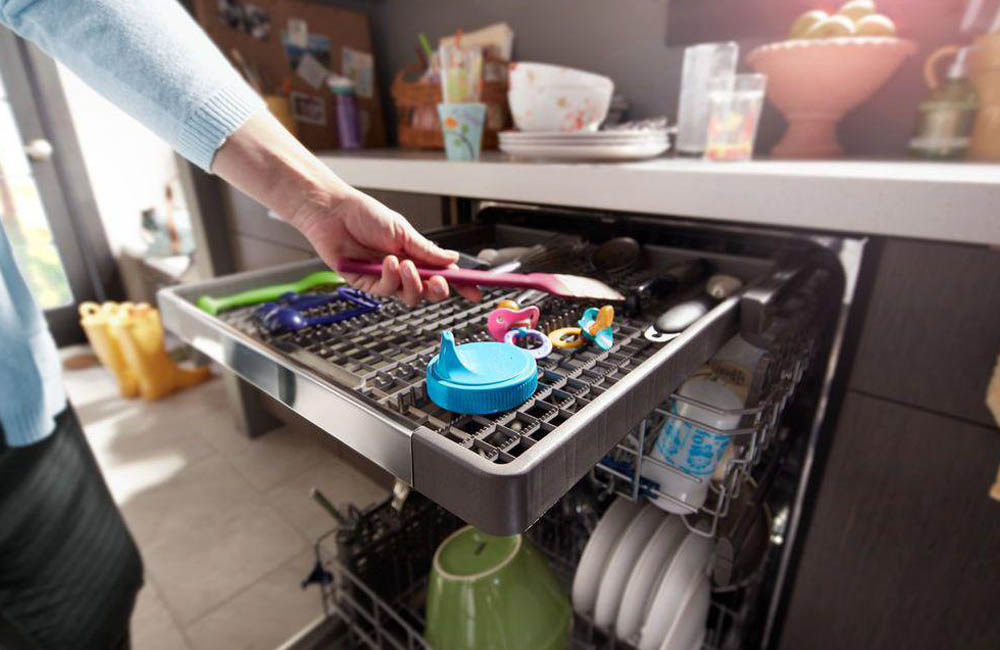
How We Chose the Best Dishwashers
When choosing the best dishwashers, we explored several features: how many wash cycles they offered; the washing, sanitizing, and drying technology with which they were equipped; whether they had adjustable racks and tines; how easy they were to install; and how much they cost in comparison to similar styles in other dishwasher brands. We also looked at their energy-saving qualities and their customer service reputations.
This curated list was developed from extensive product research. We considered all the major dishwasher brands as well as several boutique ones.
Our Top Picks
Even with a checklist of ideal features in hand, finding a dishwasher that fits the bill in such a crowded market can be overwhelming. This list includes some of the best dishwashers available today to help simplify the search. These top picks consider the abovementioned factors in addition to overall quality, price, and Energy Star certification.
Best Overall
Whirlpool 24-Inch Top Control Built-In Dishwasher
See ItThis 24-inch built-in dishwasher from Whirlpool offers a host of bells and whistles to make washing dishes a breeze. A tall tub design and third-level rack provide up to 37 percent more space for large or odd-shaped items. An in-door silverware basket also frees up rack space, while folding tines can be used to secure dishes during the wash cycle or folded down to create space for larger items.
The sensor cycle automatically selects the proper wash and dry settings for a load. The TotalCoverage spray arm cleans with more than 20 jets and an innovative sequence of spray patterns from multiple nozzles. The stainless steel construction features a fingerprint-resistant finish and controls that are situated on the top edge of the door, leaving an unencumbered front panel.
This dishwasher also offers a 1-hour wash cycle to clean lightly soiled loads in half the time as well as a full range of heavy, normal, and light cycles. A Sani-rinse option sanitizes dishes by eliminating 99.99 percent of food and bacteria.
Product Specs
- Type: Built-in
- Size: 33.625 inches high by 23.875 inches wide by 26.75 inches deep
- Wash cycles: 5
- Water usage: 3.25 to 6.75 gallons
Pros
- Speed cycle done in 1 hour
- Flexible tines fold down for extra space
- Second rack raises and lowers for tall items
- Red light indicates that a cycle is in progress
- Durable stainless steel construction
Cons
- Customers complain of glitches in control panels and hoses
- Dishes don’t always rinse and dry completely
- Plastics flip over and fill with water
Get the Whirlpool dishwasher at The Home Depot or Best Buy.
Best Bang for the Buck
Frigidaire 24-Inch Front Control Built-In Dishwasher
See ItIndividuals looking for upscale features at a budget-friendly price won’t go wrong with this Frigidaire built-in dishwasher. This standard 24-inch model can handle up to 14 place settings in one load. A removable top rack, adjustable rack heights, and removable silverware basket all accommodate large or odd-shaped pieces.
The three separate spray arms make sure all of the dishes come out clean, and the heating element reduces drying time. The unit features a 4-hour-delay start timer and a self-cleaning filter to eliminate food particles. While this dishwasher is a bit noisier than more expensive models, at 60 decibels, it offers a great combination of features at an affordable price.
Product Specs
- Type: Built-in
- Size: 33.5 to 35 inches high by 24 inches wide by 25 inches deep
- Wash cycles: 3
- Water usage: 6 gallons
Pros
- Removable top rack, adjustable rack heights, and removable silverware basket
- Large interior; fits 14 place settings per load
- No prerinsing required before running a cycle
- Heating element reduces drying time and prevents wet dishes after a load
Cons
- Plastic racks can warp and shred
- Buttons are hard to press
- Noisy wash cycle
Get the Frigidaire dishwasher at The Home Depot, Amazon, or Best Buy.
Upgrade Pick
Bosch 800 Series 24-Inch Dishwasher with CrystalDry
See ItWith a range of quality features, this 24-inch built-in dishwasher is a joy for a household of any size—from singles to families to empty-nesters. Those who enjoy cooking or who don’t accumulate that many dirty dishes at one time will appreciate the flexibility of an adjustable EasyGlide second rack, a third rack with wings that raise and lower to accommodate serving ware and utensils, and adjustable tines throughout.
With PrecisionWash technology that targets dishes with sensors and spray arms, and patented CrystalDry technology that promises to dry even the most stubborn plastics, this Bosch dishwasher is one of the most reliable dishwashers around. The Sanitize option, which reduces 99.9 percent of bacteria, and Half Load wash cycles make it even more appealing for those who want to reduce their dishwasher and water usage.
Product Specs
- Type: Built-in
- Size: 33.875 inches high by 23.5625 inches wide by 23.75 inches deep
- Wash cycles: 6
- Water usage: 1.1 to 6.4 gallons
Pros
- Second rack has 9 adjustable positions; suitable for large and small dishes
- Super-quiet wash cycles won’t disturb the household
- Interior is larger and more flexible than many expect
- 60-minute cycle is just as good as the longer cycles
Cons
- CrystalDry option not as quiet as the rest of the cycles
- Plastics occasionally flip and do not fully dry
Get the Bosch 800 Series dishwasher at The Home Depot or Best Buy.
Best Smart
LG Electronics 42dBA Smart Dishwasher QuadWash
See ItFor those who like absolute control over everything in the house, this ultraquiet built-in dishwasher featuring SmartThinQ technology is the ideal choice. Just load up the dirty dishes, download the app to a smartphone, connect it to Google or Alexa, and have Wi-Fi or voice control over the QuadWash and Hybrid Condensing Drying System cycles.
There are a lot of features to like about this dishwasher, especially for those who are climate conscious. Dual Zone technology lightens the intensity of spray on the upper rack for delicates so that it is unnecessary to wash them by hand. The Auto Cycle senses the level of encrustation on the dishes and sets itself, so it’s not wasting water or power. If there is a light load, the LG dishwasher can be set to wash only on the upper or lower rack. Like others in its class, it also has an advanced filtration system, so prewashing or rinsing isn’t required.
While the three adjustable racks glide smoothly and can be positioned in almost every way imaginable, customers complain about the tines not retaining their integrity. The racks themselves also tend to rust in spots over time. Users recommend fixing problems under warranty as soon as they’re spotted.
Product Specs
- Type: Built-in
- Size: 33.625 inches high by 23.75 inches wide by 24.625 inches deep
- Wash cycles: 10
- Water usage: 2.8 gallons
Pros
- Interior LED lighting allows for easy visibility while emptying or loading
- Dries with steam for reduced spotting
- Fingerprint-proof exterior remains clean in the long term
- Works with Alexa and Google for voice control
Cons
- The filtration food trap can clog and fill with water
- The adjustable tines fall down and stay down after a while
- Racks are prone to rust
Get the LG Electronics dishwasher at The Home Depot or Best Buy.
Best Compact
Bosch 300 Series 18-Inch Compact Dishwasher
See ItFor small kitchens or small households, this 18-inch compact dishwasher is ideal. Sleek and handsome outside and customizable inside, it holds a surprising number of dishes for a compact dishwasher. That said, if more than two or three people live in the household, it may be necessary to run it more than once per day.
With three racks that offer flexible loading, four wash cycles, and six start options—including delay start, remote start, delicate, sanitize, extra dry, and machine care—this machine is a macro cleaning-up tool for the micro kitchen. And though it’s not advertised as such, an accompanying app makes it a smart dishwasher as well as a compact dishwasher.
Fans of Bosch dishwashers also appreciate that it doesn’t need a ton of detergent and that this machine’s detergent lid doesn’t give up its snap like others eventually do. However, it also doesn’t always clean away all the mess, so some prerinsing is still required.
Product Specs
- Type: Built-in
- Size: 32.0625 inches high by 17.625 inches wide by 22.5625 inches deep
- Wash cycles: 4
- Water usage: 1 to 5.8 gallons
Pros
- Surprisingly quiet for small kitchens, where noise can be amplified
- Easy to program; 5 wash cycles and 6 start options
- Doesn’t need a lot of detergent to provide clean dishes
- Comes with an app for adjustability and control
Cons
- Doesn’t tackle stuck-on food very well
- Odd configuration of top rack limits glasses
Get the Bosch 300 series dishwasher at Amazon, The Home Depot, or Best Buy.
Best Large-Capacity
Samsung – Smart Bespoke Linear Wash 39dBA Dishwasher
See ItAt only 39 decibels, this smart dishwasher is one of the quietest available. Thanks to Whisper Quiet Cleaning performance and insulated sides, owners can’t hear the Linear Wash Technology, which uses a sliding spray bar with Aqua Blast Jets to clean thoroughly from end to end and top to bottom. But they sure can see the results.
Available in navy blue or Tuscan steel to match the brand’s refrigerators, this dishwasher is perfect for those who love to entertain. The bottom left corner is a special high-intensity zone for pots and pans, although they still benefit from a rinse before they are put in if they are to turn out spotless.
An express wash cycle—only 60 minutes—allows owners to unload and reload multiple times throughout an evening. And thanks to its AutoRelease technology, the door opens automatically after a wash cycle so that condensation doesn’t build up, turning steam to water. However, some customers complain that the pop-open feature malfunctions.
This built-in dishwasher is also a smart dishwasher, so dirty dishes can wait until the house is empty to be washed. The smartphone feature also alerts owners when a cycle is finished.
Product Specs
- Type: Built-in
- Size: 33.9 inches high by 23.9 inches wide by 25 inches deep
- Wash cycles: 7
- Water usage: 3.2 gallons
Pros
- Remote operation via SmartThings app
- Front panel LED display shows time remaining in a cycle
- Express 60-minute cycle for quick cleaning
Cons
- Third rack and second rack are too close together
- Automatic door-open feature malfunctions
- Dishes on the bottom rack don’t always come out clean
Get the Samsung dishwasher at The Home Depot or Best Buy.
Best Countertop
HomeLabs Compact Countertop Dishwasher
See ItMany people live alone, dine out a lot, or simply don’t have the space for a built-in dishwasher. Whatever the reason, a countertop dishwasher for those times when they don’t feel like handwashing is an excellent alternative. This one offers six different wash cycles: heavy, normal, ECO, glass, speed, and rinse. And it includes a delay button so it can be set to wash when occupants are out.
Easy to attach to a sink with faucet adapters, the dishwasher also accommodates rinse aids so that dishware won’t have spots and streaks. Owners can even throw a small dinner party for six people and get all those place settings washed at once.
Product Specs
- Type: Countertop
- Size: 17.24 inches high by 21.65 inches wide by 19.68 inches deep
- Wash cycles: 6
- Water usage: 3 to 5 gallons
Pros
- Can attach to a faucet for added rinse aid
- Takes up about the same space as a microwave
- Customers compliment excellent customer service
Cons
- Customers complain about an incomprehensible instruction manual
- Noisy
- Hard to load
Get the HomeLabs dishwasher on Amazon or at Walmart.
Best Portable
GE 24-Inch 54dBA Portable Dishwasher
See ItBuilt on wheels so it can be moved from place to place, this high-performance portable dishwasher has as many features as a built-in dishwasher. An Autosense Cycle checks the level of soiling and ascertains how much water pressure, temperature, and time is required, adjusting accordingly. The Piranha Hard Food Disposer minces food waste and disposes of it. A National Sanitation Foundation (NSF)-certified Sanitize Option eliminates 99.999 percent of the bacteria lingering on used dishware.
On the downside, all those upgrades come with a cost, making this a heavy machine to move. Cleaning cycles are as long as a built-in, as well. Customers have complained about assembly being difficult and, while hooking it up is easy for those who have standard faucets, it’s much more difficult for those with anything old-fashioned or out of the ordinary. It’s also a bit on the noisy side. Still, this portable dishwasher is so modern it can even be Wi-Fi enabled.
Product Specs
- Type: Portable
- Size: 36 inches high by 23.63 inches wide by 25.38 inches deep
- Wash cycles: 3
- Water usage: 2.4 to 6.6 gallons
Pros
- Easy hookup for those with standard faucets
- Can be Wi-Fi enabled for easy smartphone control and adjusting
- Runs more quietly than expected; won’t disturb a household while operational
Cons
- Heavy and hard to move
- Assembly, especially attaching wheels, can be difficult
- Wheels on lower rack not sturdy
Get the GE dishwasher at The Home Depot or Best Buy.
Jump to Our Top Picks
What to Consider When Choosing the Best Dishwasher
Even for those who already own a dishwasher, there is a lot to gain by purchasing a new model. Besides conserving water, there’s a compelling financial reason to upgrade: An Energy Star-certified dishwasher could save owners more than $40 per year. The market features abundant options, from basic budget-friendly to fully programmable smart models. Those who are not sure where their needs fall in the spectrum should keep these key shopping factors in mind.
Size and Capacity
Dishwashers usually come in two sizes. Standard built-in dimensions are 34 inches high (34 inches being the height of most countertops and base cabinetry) by 24 inches wide. Compact models are 34 inches high by 18 inches wide, though some are designed for shorter 32-inch countertops found in handicapped-accessible kitchens. Portable units typically measure 34 to 38 inches high by 20 to 25 inches wide by 27 to 30 inches deep. Standard and portable washers are usually fitted with two or three racks, while a compact unit holds one or two racks.
A dishwasher’s capacity is generally measured by the number of place settings it can hold in one load. Standard dishwashers typically accommodate from eight to 12 place settings, with some handling up to 16 settings. Compact dishwashers typically accommodate six to 10 place settings per load.
In any case, adjustable upper racks and removable baskets earn bonus points, as either feature provides extra space for awkwardly shaped or larger items. Dishwashers in custom sizes are available by special order, but be prepared to pay more.
Wash Settings
The number and types of cycle selections vary from dishwasher to dishwasher, and finding the ideal combination for individual needs will often be the deciding factor in a purchase. A typical dishwasher usually features three settings: a normal wash cycle that runs from 90 to 135 minutes, a heavy cycle for pots and pans, and a light (also known as delicate) cycle for stemware.
Pricier models offer additional options, including a programmable or “smart” mode, prerinse option, “quick-wash” function, “rinse-and-hold” cycle, a delicate china cycle, and a heavy-duty sanitizing cycle.
Some dishwashers also offer a selection of drying cycles, including heated drying, quick drying, and “eco” mode. Many units feature a programmable delayed-start option, allowing owners to run the dishwasher after guests are gone and the family is in bed or after leaving for work in the morning.
Water Usage and Energy Efficiency
According to the Environmental Protection Agency, “Replacing existing dishwashers with Energy Star–labeled models reduces water use by up to 65 percent and reduces energy use by more than 10 percent. A new Energy Star-certified dishwasher will save, on average, 3,870 gallons of water over its lifetime.” Some upscale dishwashers even include an “eco” cycle that utilizes less water, while others have a sensor that determines how dirty the dishes are and adjusts the water usage and cycles automatically.
Dishwashers on the market today are required by law to carry an “Energy Guide” label that estimates the annual power consumption and yearly operation cost based on national-average natural gas and electricity prices. Look for the Energy Star logo, which indicates that the unit meets or exceeds the federal minimum standards for efficiency and quality. Using an Energy Star-certified model also helps reduce the use of fossil fuels, which reduces air pollution and protects the climate.
Noise Level
The last thing anyone wants to do while relaxing after dinner is to shout over the noise of the dishwasher. Dishwasher noise is rated in decibels: the louder the noise, the higher the decibel level. Newer models boast thicker insulation, resulting in noise levels around 45 decibels. For reference, 50 decibels is roughly equivalent to the volume of a conversation.
Most dishwashers have a noise level between 46 and 50 decibels during normal operation. For a quieter dishwasher, look for a model at or below 45 decibels. Some whisper-quiet dishwashers clock in at 30 decibels, which means owners most likely won’t hear them even in the kitchen, but they can expect to pay a premium for this peace and quiet.
Additional Features
Dishwasher technologies have come a long way in recent years. Here are a few features we love that are included by some dishwasher brands:
- A third rack is typically a narrow rack that sits above the top rack and may have a separate wash arm.
- Adjustable-height racks usually have foldable tines and innovative spray arms to move wash water more efficiently, as well as stemware clips, spray nozzles, special cutlery racks, programmable controls, and child locks.
- Adjustable-rack designs include specialized “zones” to improve cleaning performance on some of the toughest grease and grime.
- Integrated and multistage water filtration removes food particles from the wash water and utilizes fan-assisted or heated drying.
- Soil-sensor technology determines how dirty the dishes are and automatically adjusts the cycle to optimize cleaning performance while minimizing water and energy use.
- Smart-home technology and Wi-Fi connectivity are programmable via a computer or smartphone.
- Insert panels are included with some models to match and blend in with cabinetry.
- Stainless steel, mirrored finishes, and colored finishes integrate into an existing kitchen seamlessly (depending upon current fixtures) providing a sleek, elevated look.
- Fingerprint-resistant finishes are also popular to help keep the exterior as sparkling clean as the dishes inside.
Installation
Installation first depends on what type of dishwasher is being installed: standard or compact. Buyers might choose to locate the dishwasher under the sink or in a kitchen island. Regardless, they will need plumbing and electrical outlets to connect it.
Installation of a dishwasher can take from 90 minutes to 2 hours for someone who is handy and good at reading instruction manuals. However, given the complex nature of hooking up plumbing hoses and electrical connections, calling in a professional might be preferred.
Brand
In addition to the dishwasher features listed above, you may also want to consider narrowing your search by brand. Many of the best dishwasher brands carry features like energy efficiency, adjustable rack heights, and even wifi and smart capabilities. Here are the brands we trust and recommend:
- Bosch: Bosch is a German appliance and electronics company best known for sleek, functional designs that never sacrifice quality for eye-catching features.
- GE: The high level of durability in GE appliances has made this company a household name throughout America and increased its popularity worldwide.
- LG: LG Electronics is considered a high-end electronics brand, so it’s no surprise that its dishwashers are known for Wi-Fi and smart-home compatibility.
- Whirlpool: Whirlpool excels in creating reliable designs that focus on energy efficiency and durability. It has a history in appliance manufacturing, as well as several important acquisitions over the years.
- KitchenAid: KitchenAid takes a different approach to kitchen appliances, preferring to diversify its product offerings instead of focusing on a specific niche, which gives users a range of versatile options.
- HomeLabs: HomeLabs specializes in countertop dishwashers, ideal for apartments and small kitchens. It’s also renowned for other home appliances such as air purifiers, dehumidifiers, and air conditioners.
- Maytag: Big families and overzealous chefs appreciate the spacious dish racks and powerful wash cycles standard in Maytag’s dishwashers.
- Samsung: Samsung is one of the best-known electronics companies in the world thanks to its popular line of smartphones, and Samsung appliances are made with the same market-leading innovation.
- Fisher & Paykel: Though Fisher & Paykel isn’t one of the first brand names to come to mind, it is the leading manufacturer of drawer-style dishwashers, capitalizing on this niche design.
- Amana: Amana designs and manufactures affordable kitchen appliances, like dishwashers, refrigerators, and ovens, to help budget-conscious families upgrade their kitchen without emptying their wallets.
- Café: GE created this brand in 2018, and it has grown quickly in popularity with products specifically made to appeal to individuals interested in a distinct, high-end aesthetic appearance.
Types of Dishwashers
Today, dishwasher users can choose from a variety of models, including conventional built-in units and compact or countertop models that are suitable for apartments or tiny houses. There are even portable options to take “on the road” in an RV or camper, along with conventional built-in units designed to fit under a standard countertop.
Built-In
Today’s conventional dishwashers are built-in models designed to go underneath a countertop. They usually are situated near the kitchen sink, due to the necessity of a plumbing connection, but some dishwashers are built into a center island. Built-in models come in two sizes: standard and compact.
A standard-size dishwasher measures 34 inches high by 24 inches wide and between 24 and 28 inches deep. These models typically handle between 8 and 12 place settings per load, though some can accommodate up to 16 settings.
Compact built-in dishwashers are also known as “18-inch dishwashers”; a typical compact unit measures 17 to 18 inches wide and 22 to 26 inches deep. The height varies from 32 to 34 inches, with the lower height accommodating the Americans with Disabilities Act requirements for lower kitchen countertops. These units typically handle 6 to 10 place settings per load.
Portable
Portable dishwashers are fairly similar to the original vintage models but are much more efficient and far less messy. They are popular among renters or people with smaller kitchens. These units are usually on wheels and easily stowed in a closet when not in use.
Some of the taller portable models feature an integrated countertop to provide extra kitchen prep space while in use. But even these smaller, more maneuverable units can be pretty handy to have around and don’t require installation. Most portable dishwashers accommodate between eight and 12 place settings.
Countertop
Countertop dishwashers are similar to portable dishwashers in that they are smaller and easy to stow away when not in use. As the name implies, countertop dishwashers are designed to sit on a counter. The water intake hose connects to the kitchen sink faucet (or bar sink faucet, if the dishwasher is an entertaining accessory), and a drain hose releases the dirty water into the sink. A nearby electrical outlet is also needed to provide power.
Countertop dishwashers have a smaller “footprint” than most built-ins, taking up roughly twice the size of a microwave oven. Typical countertop units hold from six to eight place settings. One advantage of countertop models is that they are very water and energy efficient.
FAQs
Dishwashers have become a standard accessory in modern kitchens, but even with nearly ubiquitous use, there are still some tips that help users gain the most benefit from this handy kitchen helper. Here are several of the most frequently asked questions about these convenient appliances.
Q. How do you install a dishwasher?
Dishwasher installation can be a DIY project, but given the fact that it involves both plumbing and electrical connections, you might want to call in a professional. For those determined to go it alone, installation will probably take anywhere from 90 minutes to 2 hours.
- Read the manufacturer’s instructions and gather the requisite tools: tape measure, hose clamps, wrench, electrical tape, screwdriver, and a dishwasher installation kit containing the supply lines and other components.
- Before you begin, turn off the power and water to the area.
- Determine the unit’s placement based on the availability of plumbing and electrical connections. You will need a water intake connection and a drain connection, which is why most dishwashers are located near the kitchen sink.
- Drill a hole through the sidewalls of the cabinetry to run the water, drain, and electrical lines.
- Connect the drain line and the water line. You will need a fitting called a “dishwasher 90” for the water line; this is a 90-degree angled elbow that allows the water line to lie flat rather than bending at an angle.
- Secure the electrical connections and test the dishwasher for power.
- Level the unit using a wrench on the “legs” underneath the dishwasher, and secure it in place with the screws that came with the unit.
- Run the unit, checking for leaks; you may need to reclamp the hoses if there are any leaks.
Q. How long does a dishwasher last?
Several variables affect a dishwasher’s lifespan, including how often you run the unit and how well you clean and maintain it. The average household runs about four to five loads per week. Dishwashers will typically last anywhere from 9 to 16 years, with an average life expectancy of about 12 years.
Dishwashers with stainless steel tubs and spray arms usually last longer than units with plastic components. Professional maintenance and regular cleaning, such as wiping down the door seals, cleaning the food trap and filter, and prescraping or rinsing dishes, can extend the lifespan.
Q. What certifications should I look for in a dishwasher?
Energy Star–certified dishwashers reduce water use by up to 65 percent and energy use by more than 10 percent over non-Energy Star-certified models. The CEE Rating is assigned by the Consortium for Energy Efficiency, a group that works with manufacturers to build appliances that reduce energy consumption. There are three tiers for CEE ratings, and a higher tier equates to a higher level of energy efficiency.
NSF-certified dishwashers have an optional “sanitizing” feature that allows them to run at a very high temperature to kill 99 percent of bacteria. ADA-compliant dishwashers are designed to accommodate the requirements of the Americans with Disabilities Act.
Q. How do you get rid of the bad smell in the dishwasher?
Sometimes, even the cleanest kitchens will be the source of funky smells. The dishwasher is often a likely culprit since food residue, grease, and grime can build up over time.
To keep bad smells at bay, regularly clean the filter and food trap. Use a damp microfiber cloth to wipe down the inner surfaces, spray arms, and racks. For a deeper clean, fill a glass with 1 cup of distilled white vinegar, and run the dishwasher through a single cycle using the hottest water possible. Repeat every few months to keep your dishwasher squeaky clean and odor-free.
Q. Which is better: dishwasher pods or powder?
The question of pods versus powder comes down to a few variables, but for maximum dishwasher performance, you need to use the correct amount of detergent. Because pods are premeasured, it takes some of the guesswork out of the process. Pods also are convenient, which is one reason they are so popular, with more than 70 percent of dishwasher detergent now sold in pod form. Pods are, however, pricier than powder.
Q. Are pods better than liquid?
Similar to the question of pods versus powder, measuring your dishwasher detergent is important. Some people use far too much liquid detergent, creating too many suds and leaving a cloudy film on dishes. Pods deliver a combination of convenience, cleaning power, and reliable measurement, but again, they cost more than liquid detergents.
Why Trust Bob Vila
Bob Vila has been America’s Handyman since 1979. As the host of beloved and groundbreaking TV series including “This Old House” and “Bob Vila’s Home Again,” he popularized and became synonymous with “do-it-yourself” home improvement.
Throughout his decades-long career, Bob Vila has helped millions of people build, renovate, repair, and live better each day—a tradition that continues today with expert yet accessible home advice. The Bob Vila team distills need-to-know information into project tutorials, maintenance guides, tool 101s, and more. These home and garden experts then thoroughly research, vet, and recommend products that support homeowners, renters, DIYers, and professionals in their to-do lists.
